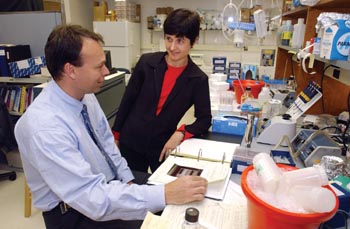
Dr. Jeffrey Balser and Sabina Kupershmidt, Ph.D. discuss data related to their studies of cardiac proteins and arrhythmias. Dana Johnson
Heart protein could prevent drug-induced arrhythmias
The rhythmic contractions of the beating heart depend on a carefully choreographed flow of electrically charged “ions” into and out of cardiac cells, through specialized pore proteins called ion channels. Missteps in the ion channel routine can put individuals at risk for life-threatening arrhythmias.
One ion channel in particular, a potassium channel called HERG, can be blocked by a variety of medications, leading to arrhythmias in susceptible individuals. Cardiac arrhythmias are the leading cause of sudden death in the United States, according to the American Heart Association.
“It’s peculiar that this potassium current is sensitive to a huge variety of drugs, including over-the-counter medicines like antihistamines,” said Sabina Kupershmidt, Ph.D., assistant professor of Anesthesiology and Pharmacology. “We don’t know for sure what makes some people susceptible to this drug blockade of HERG, but we suspect there are modulating factors.”
Kupershmidt and collaborators have characterized one such potential factor, a protein called KCR1. The investigators demonstrated, using cardiac cells grown in the laboratory, that KCR1 prevents certain drugs from blocking the HERG channel. Their findings, reported earlier this month in The FASEB Journal, are the first to show that another protein can impede drug blockade of HERG.
“The number of drugs that block HERG and can cause potentially fatal arrhythmias is very large,” said Dr. Jeffrey R. Balser, professor and chair of Anesthesiology and a co-author of the current publication. “The FDA is now insisting that all new drugs that are marketed be tested for their HERG-blocking potential. So the whole issue surrounding HERG and its regulation is becoming a major issue in biomedical science and pharmacology.”
“We believe our findings will be of interest to both science and industry, to see whether the KCR1 protein can be used to modulate HERG susceptibility to other drugs,” Kupershmidt said. The investigators have applied for a patent on KCR1, because of its potential for preventing HERG blockage and the resultant arrhythmias in unsuspecting individuals. Kupershmidt cautions that the studies are at a very early stage.
“There is really nothing known about KCR1,” she said. “We’re only at the first step of figuring out the relationship between the channel and this modifier protein. Once we establish the mechanism, it may be possible to find ways to mimic this mechanism and prevent unwanted blockade of the potassium current.”
Kupershmidt’s laboratory is currently following a lead that the KCR1 protein may participate in the addition of sugar groups to the HERG protein — part of the processing of the ion channel before it reaches the cell membrane. If the HERG protein is not fully processed — because of its interaction with KCR1 — she said, then it might have a different conformation and different drug accessibility.
Variable KCR1 function might account for the range of susceptibility of individuals to HERG blockade, Kupershmidt added.
Vanderbilt collaborators included Iris C.-H. Yang, Kenshi Hayashi, Jian Wei, Siprachanh Chanthaphaychith, Christina I. Petersen, Alfred L. George, Jr. and Dan M. Roden. The research was supported by the American Heart Association and the National Institutes of Health.













